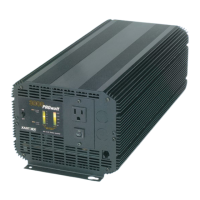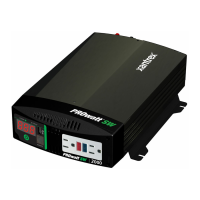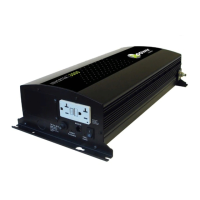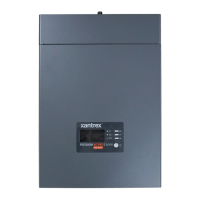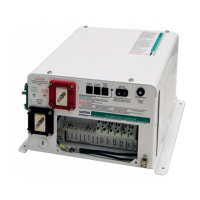SECTION 3 INSTALLATION
445-0089-01-01
21
AC Cabling
AC cabling includes all the wires and connectors between the AC
source and the inverter•charger and all cabling between the inverter•charger
and the AC panels, circuit breakers, and loads. The type and size of the wiring
varies with the installation and load. For marine and some RV applications,
flexible multiple-strand wire is required. For residential installations, solid
Romex™ cable is often used. Installation codes may specify solid or stranded,
overall size of the conductors, and type and temperature rating of the
insulation around the wire.
AC wiring must be sized to match the current rating of the AC breakers you
provide on the input and output AC circuits in accordance with the electrical
codes or regulations applicable to your installation. Table 1 is based on the
U.S. National Electrical Code and the Canadian Electrical Code, assuming 2-
conductor-plus-ground cable. Other codes and regulations may be applicable
to your installation.
AC Output Neutral Bonding
The neutral conductor of the
inverter•charger’s AC output circuit is automatically connected to the safety
ground during inverter operation. When AC utility power is present and the
inverter•charger is in Charger mode, this connection is not present, so that the
utility neutral is only connected to ground at your source panel. This conforms
to National Electrical Code requirements that separately derived AC sources
(such as inverters and generators) have their neutral conductors tied to ground
in the same way that the neutral conductor from the utility is tied to ground at
the AC source panel.
DC Cabling
This includes all the cables and connectors between the batteries,
the DC disconnect and over-current protection device, and the
inverter•charger. All installations require multi-strand insulated cables as well
as disconnect and over-current devices. DC cable sizes are indicated by AWG
notation or MCM notation. Under the AWG standard, a larger gauge number
indicates a smaller wire diameter. Under the MCM standard, a larger number
indicates a larger cable. Wire size is usually marked on the cables for sizes this
large. Table 2 specifies the minimum DC cable size and maximum fuse size
for the PROsine 2.0.
The DC cables must be copper and must be rated
75°C minimum.
Table 1 Required AC Wire Size vs Breaker Rating
Breaker Size
10A 15A 20A 30A
Minimum
Wire Size
14AWG 14AWG 12AWG 10AWG
Table 2 Required DC Cable and Fuse Size
DC Cable Length Cable Size Fuse Amps
Less than 6 feet 250MCM 300A class T
Between 6 and 12 feet 350MCM 300A class T

